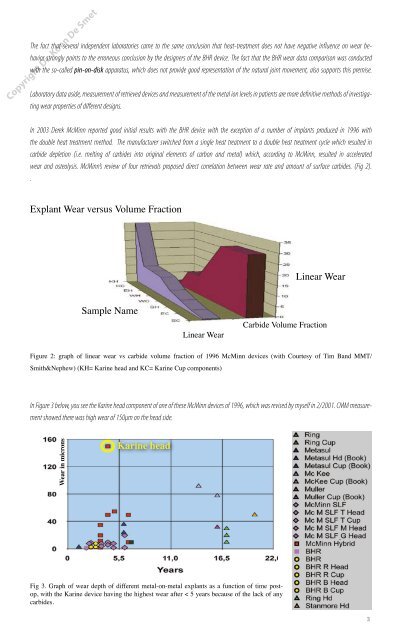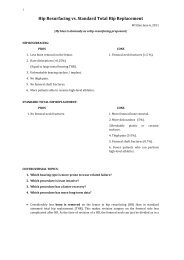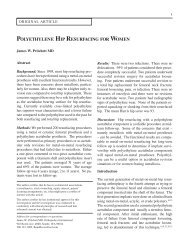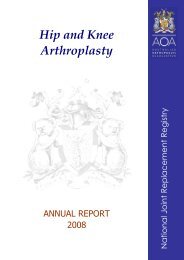Birmingham H ip Resurfacing v ersus C onserv e Plus M etal-on-M ...
Birmingham H ip Resurfacing v ersus C onserv e Plus M etal-on-M ...
Birmingham H ip Resurfacing v ersus C onserv e Plus M etal-on-M ...
Create successful ePaper yourself
Turn your PDF publications into a flip-book with our unique Google optimized e-Paper software.
The fact that several independent laboratories came to the same c<strong>on</strong>clusi<strong>on</strong> that heat-treatment does not have negative influence <strong>on</strong> wear behavior<br />
str<strong>on</strong>gly points to the err<strong>on</strong>eous c<strong>on</strong>clusi<strong>on</strong> by the designers of the BHR device. The fact that the BHR wear data comparis<strong>on</strong> was c<strong>on</strong>ducted<br />
with the so-called pin-<strong>on</strong>-disk apparatus, which does not provide good representati<strong>on</strong> of the natural joint movement, also supports this premise.<br />
Laboratory data aside, measurement of retrieved devices and measurement of the m<str<strong>on</strong>g>etal</str<strong>on</strong>g> i<strong>on</strong> levels in patients are more definitive methods of investigating<br />
wear properties of different designs.<br />
Copyright Dr. Koen De Smet<br />
In 2003 Derek McMinn reported good initial results with the BHR device with the excepti<strong>on</strong> of a number of implants produced in 1996 with<br />
the double heat treatment method. The manufacturer switched from a single heat treatment to a double heat treatment cycle which resulted in<br />
carbide depleti<strong>on</strong> (i.e. melting of carbides into original elements of carb<strong>on</strong> and m<str<strong>on</strong>g>etal</str<strong>on</strong>g>) which, according to McMinn, resulted in accelerated<br />
wear and osteolysis. McMinn’s review of four retrievals proposed direct correlati<strong>on</strong> between wear rate and amount of surface carbides. (Fig 2).<br />
.<br />
Explant Wear v<str<strong>on</strong>g>ersus</str<strong>on</strong>g> Volume Fracti<strong>on</strong><br />
Figure 2: graph of linear wear vs carbide volume fracti<strong>on</strong> of 1996 McMinn devices (with Courtesy of Tim Band MMT/<br />
Smith&Nephew) (KH= Karine head and KC= Karine Cup comp<strong>on</strong>ents)<br />
In Figure 3 below, you see the Karine head comp<strong>on</strong>ent of <strong>on</strong>e of these McMinn devices of 1996, which was revised by myself in 2/2001. CMM measurement<br />
showed there was high wear of 150µm <strong>on</strong> the head side.<br />
Wear in micr<strong>on</strong>s<br />
Sample Name<br />
Karine head<br />
Linear Wear<br />
Fig 3. Graph of wear depth of different m<str<strong>on</strong>g>etal</str<strong>on</strong>g>-<strong>on</strong>-m<str<strong>on</strong>g>etal</str<strong>on</strong>g> explants as a functi<strong>on</strong> of time postop,<br />
with the Karine device having the highest wear after < 5 years because of the lack of any<br />
carbides.<br />
Linear Wear<br />
Carbide Volume Fracti<strong>on</strong><br />
3






